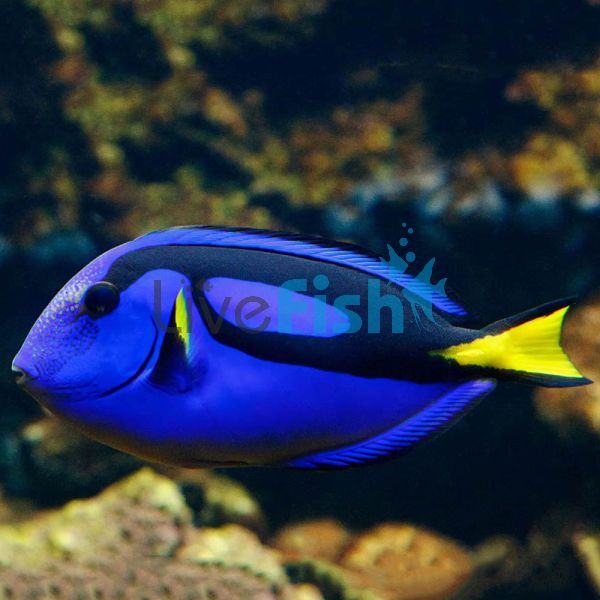Blue Tang - Medium
The Blue Tang is one of the most popular marine aquarium fish in the world. It's recognizable from the Pixar movies Finding Nemo and Finding Dory, the forgetful fish who helped Nemo's dad find him in the first movie.
It has a striking body coloring of electric blue and canary yellow. The blues tend to emerge later, juveniles are bright yellow, if an adult flushes darker blues or violets it is a sign of stress. There is a black marking that travels from its’ eyes down to the tail and back above the pectoral fin. The marking resembles the shape of a painters’ palette, which accounts for one of its’ alternative names – the Palette Surgeonfish.
Blue Tangs use venom as a form of self-defense, a sharp spine in their caudal fin contains a toxin. This can cause extreme pain to predators and humans.
They have also been known to cause ciguatera poisoning to people who have eaten them.
The Blue Tangs’ usual habitat is among reefs, with plenty of hiding places amongst rocks.
It is an active fish so an aquarium should also have enough room for it to swim freely.
Reproduction involves a method called broadcast spawning. The females release eggs above the coral and the males release sperm to fertilize them. The Blue Tang can reach a total length of 25-31 centimeters (10-12 in). Its’ lifespan in an aquarium is anywhere between 8-20 years.
Tank Requirements for the Blue Tang
Minimum tank size is usually recommended at 380 liters (100 gallons), if you have more than 1 Tang then 200 gallons is optimal.
Blue Tang needs an aquarium that contains coral, rocky hiding places, and plenty of open space for swimming.
Maintaining water quality is important for these fish if they are to be successfully kept in captivity.
This will also help to reduce the incidence of marine white spots, which can flare in these fish if they become stressed.
The best way of avoiding this is to check the water quality regularly, feed a nutritious diet, and ensure that they have correct housing and you will get many years of pleasure from these beautiful fish.
Suitable Tank Buddies
Blue Tangs are generally non-territorial and get along with most species.
Usually Compatible
Suitable tank buddies include the Cardinals, Clownfish. large Angels, Chromis, and Wrasses.
Sometime Compatible
Blue Tang is not good at co-habiting with other surgeonfish, especially other Blue Tang, if the tank is too small or they are not introduced as a group.
If the aquarium is large enough (over 100 gallons) it is possible to have groups. You should introduce Blue Tang to the tank at the same time.
Both tank size and order of introduction can escalate territorial aggression in an aquarium.
Rarely Compatible
Slow swimmers like Seahorses and Pipefish don't mix well with these faster swimmers.
Feeding Your Blue Tang
Blue Tang are omnivorous, they will eat meaty food such as brine shrimp, mysis shrimp, and krill, but also need marine-based algae and seaweed. They will also accept frozen foods.
They may also accept nori sheets (sushi paper). You can attach a nori seaweed sheet to a feeding clip in the aquarium.
Blue Tang are grazers so they consume a lot of food. Ensure there is plenty of live rock in an aquarium for them to graze on.
They will eat from anywhere in the tank and will forage at the bottom of the tank.
Feeding them algae and seaweed 3 times per week is recommended, whilst lettuce should not be included in their diet.
| Scientific Name | Paracanthurus Hepatus |
|---|---|
| Care Level | Moderate |
| Common Names | Dory, Royal Blue Tang, Regal Tang, Palette Surgeonfish, Blue Surgeonfish, Hippo Tang, Flagtail Surgeonfish, Blue Hippo Tang, Pacific Regal Blue Tang. |
| Diet | Omnivore |
| Fish Family | Acanthuridae |
| Lifespan (years) | 16 |
| Max. Length (cm) | 31 |
| Min. Tank Volume (l) | 380 |
| Origin | Indo-Pacific region |
| Reef Safe | Yes |
| Sociability | Semi-aggressive |
| Venomous | Yes |
| Water Conditions | 24-27° C (76-80° F), dKH 8-12, pH 8.1-8.4, sg 1.020-1.025. |




